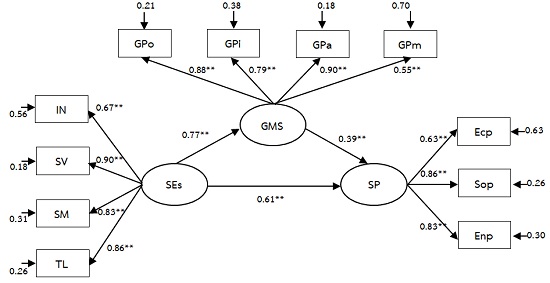A PATTERN OF A CAUSAL RELATIONSHIP BETWEEN SOCIAL ENTREPRENEURSHIP AND GREEN MARKET STRATEGY ON SUSTAINABLE SOCIAL ENTERPRISE MANAGEMENT IN THAILAND
DOI:
https://doi.org/10.14456/nrru-rdi.2022.73Keywords:
Social entrepreneurs, Green market strategy, Sustainable management outcome, Social enterpriseAbstract
The creation of competitive advantage makes an organization stronger and eventually independent. This research aimed to verify a pattern of a causal relationship between sustainable social enterprise management in Thailand. Four hundred and ten samples were recruited according to the structural equation model (SEM) analysis criteria. Questionnaires were created and had a whole reliability of 0.70. The questionnaires were mailed to the participants and data were delivered back by post. In the end, 253 data were received. Inferential statistics were used to check an acceptable level of consonance. Then the hypothesis was tested using a regression coefficient and multiple correlation coefficient squares. Results showed that, after model adjustment, a causal relationship of sustainable social enterprise management in Thailand was associated with evidence-based data. The most important variable of social entrepreneurs was being social value creators. Meanwhile, the marketing channel was the most prominent variable in the green market strategy. Finally, the social outcome was a pivotal factor for sustainable management. Overall, it could be explained with an outcome variance of 89% and a significant influence on social enterprises (P=0.01). In conclusion, a pattern of a causal relationship between social entrepreneurship and green market strategy on sustainable social enterprise management in Thailand relies on the social values of the creators, marketing channels, and social outcomes.
References
Bytyqi, N., Mestani, N., Mehmeti, H., Muji, S., & Mehaj, E. (2022). Factors influencing consumers’ behaviour and purchase of milk and dairy products in the green market of Kosovo. Journal of Hygienic Engineering and Design, 38, 292-297.
Cronbach, L. J. (1984). Essential of psychology testing. New York : Harper.
Dees, J. G. (2001). The meaning of “social entrepreneurship.” Center for the Advancement of Social Entrepreneurship.
García-Salirrosas, E. E., & Rondon-Eusebio, R. F. (2022). Green Marketing Practices Related to Key Variables of Consumer Purchasing Behavior. Sustainability, 14(14), 1-19. 8499. https://doi.org/10.3390/su14148499
Gunday, G., Ulusoy, G., Kilic, K., & Alpkan, L. (2011). Effects of innovation types on firm performance. International Journal of production economics, 133(2), 662-676.
Hair, J. F. Jr.; Black, W. C.; Babin, B. J.; & Anderson, R. E. (2010). Multivariate Data Analysis: A Global Perspective (7th ed.). New York : Pearson.
Khan, M. A. (2011). Climate change, vulnerabilities and South Asia: issues, challenges and options. Massachusetts : Edward Elgar.
Khaosa-ard, M., & Rayanakhon, K. (2009). Economic tools for environmental management. Bangkok : Office of the Health Promotion Foundation (ThaiHealth). (In Thai)
Kline, T. (2005). Psychological testing: A practical approach to design and evaluation. Thousan Oaks, CA : Sage Publications.
Koehne, F., Woodward, R., & Honig, B. (2022). The potentials and perils of prosocial power: Transnational social entrepreneurship dynamics in vulnerable places. Journal of Business Venturing, 37(4), 1-18. 106206. https://doi.org/10.1016/j.jbusvent.2022.106206
Lall, S. A., & Park, J. (2022). How social ventures grow: Understanding the role of philanthropic grants in scaling social entrepreneurship. Business & Society, 61(1), 3-44. https://doi.org/10.1177/0007650320973434
Lawrence, P., & Weber, L. (2008). “Get Ready for Migration: Clean-Up Your Collection”—What Does That Mean?. Journal of access services, 5(3), 373-381.
Mohanasundaram, V. (2012). Green marketing: Challenges and opportunities. International Journal of Multidisciplinary Research, 2(4), 66-73.
Office of Small and Medium Enterprises Promotion (OSMEP). (2016). Report on the number of entrepreneurs and employment. Retrieved August 14, 2020, from http://119.63.93.73/ sme2015/Report/View/1188 (In Thai)
Office of Social Enterprise Promotion. (2019). Social Enterprise Promotion Act B.E. 2562. Retrieved August 14, 2020, from https://www.osep.or.th/ดาวน์โหลด/ (In Thai)
Office of Social Enterprise Promotion. (2020). Announcement of the list of businesses registered as social enterprises. Retrieved April 9, 2021, from https://www.osep.or.th/ดาวน์โหลด/ (In Thai)
Polonsky, M. J. (2011). Transformative green marketing: Impediments and opportunities. Journal of business research, 64(12), 1311-1319.
Singh, P. B., & Pandey, K. K. (2012). Green marketing: policies and practices for sustainable development. Integral Review, 5(1), 22-30.
Smith, W. K., & Besharov, M. L. (2019). Bowing before dual gods: How structured flexibility sustains organizational hybridity. Administrative Science Quarterly, 64(1), 1–44.
Sri-saard, B. (2017). Preliminary research (10th ed.). Bangkok : Suwiriyasan. (In Thai)
Sumner, L. W., Amberg, A., Barrett, D., Beale, M. H., Beger, R., Daykin, C. A., ..., & Viant, M. R. (2007). Proposed minimum reporting standards for chemical analysis. Metabolomics, 3(3), 211-221.
Tiwari, S., Tripathi, D. M., Srivastava, U., & Yadav, P. K. (2011). Green marketing-emerging dimensions. Journal of Business Excellence, 2(1), 18.
UNIDO. (2018). The 2030 agenda for sustainable development: achieving the industryrelated goals and targets. Vienna : UNIDO.
West III, P. G., & Bamford, C. E. (2010). Strategy: Sustainable advantage and performance. Canada : South-Western Cengege Learning.

Downloads
Published
How to Cite
Issue
Section
License

This work is licensed under a Creative Commons Attribution-NonCommercial-NoDerivatives 4.0 International License.




